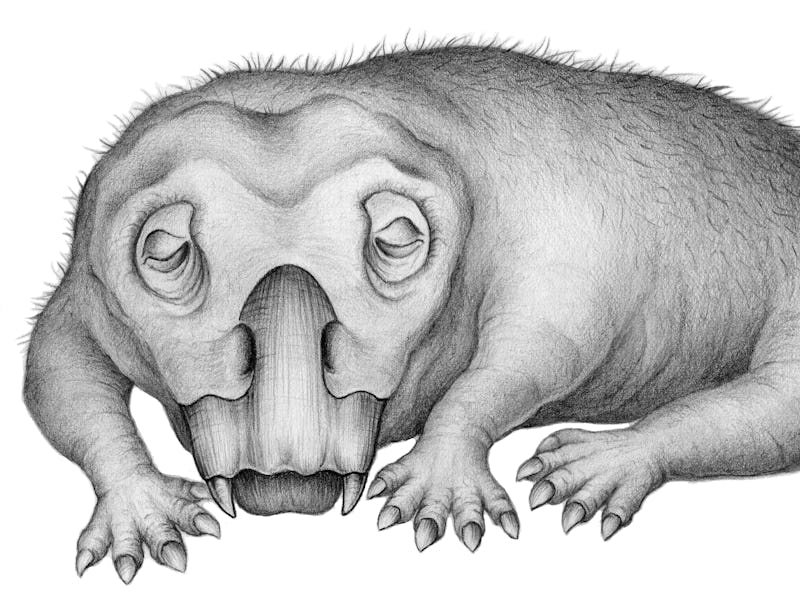250-million-year-old fossil reveals hibernation's ancient history
Meet the Lystrosaurus.

When faced with the hardship of frigid weather, some animals have a built-in survival mode: sleep.
Hibernation-like behavior in the Antarctic Circle may date back 250 million years, new fossil records show, predating the evolution of mammals and dinosaurs.
The evidence comes in the form of a curious "pre-mammal," the Lystrosaurus.
Lystrosaurus was a genus of therapsids, animals distantly related to mammals. Most Lystrosauruses were the size of pigs, but they could get bigger — up to 8 feet long — and foraged for plants. The extraordinarily Pokemon-like creatures had squat frames, turtle-like beaks, and tusks that grew continuously.
Those tusks were crucial in helping researchers determine whether Lystrosaurus spent time in torpor, a hibernation-like state of deep sleep. These toothy protrusion provided hard evidence of the stress that comes with weathering cold, hard times.
Scientists took thin cross-sections of tusks from six Lystrosaurus discovered in Antarctica. They analyzed the fossils to measure the animals' growth and stress during its lifetime.
Rings on the animals' tusks were deposited as the tusks grew. Distinct patterns indicated long periods of stress associated with torpor: The rings were thick and closely spaced, for instance.
It's the earliest known evidence of torpor, a state which involves an organism lowering its metabolism. The adaptation helps polar fauna survive when days are dark and cold, and food supply is limited.
With the Lystrosaurus sample, scientists are closer to understanding Antarctic life during the Early Triassic. The findings suggest that long before humans were around, animals were figuring out sleepy ways to deal with a harsh climate.
The study was published Thursday in the journal Communications Biology.
Thin sections of the Lystrosaurus tusk.
True hibernation — While Lystrosaurus seems to have spent time chilling out during stressful environmental conditions, evidence of torpor isn't the same as true hibernation.
Hibernation involves weeks-long changes to an individuals' metabolism, activity, and body temperature. Torpor refers to any change in metabolic activity. So it's possible that Lystrosaurus spent a shorter time in its subdued state, not quite qualifying as a hibernator.
Still, the new evidence helps to explain what success looked like in ancient Antarctica. Extreme variations in daylight gave animals more reason to lay low during parts of the year. It's possible that contemporaries of Lystrosaurus also went into restful states to survive.
What makes the Lystrosaurus valuable, is that its ever-growing tusks give scientists proof of the practice.
Lystrosaurus in torpor.
"To see the specific signs of stress and strain brought on by hibernation, you need to look at something that can fossilize and was growing continuously during the animal's life," study co-author Christian Sidor, a University of Washington biology professor, said in a statement.
"Many animals don't have that, but luckily Lystrosaurus did."
Abstract: Antarctica has hosted a wide range of ecosystems over the past 500-million years. Early in the Mesozoic, the Antarctic portion of southern Pangaea had a more habitable climate, but its position within the polar circle imposed extreme photoperiod seasonality on its resident flora and fauna. It remains unclear to what degree physiological adaptations underpinned the ability of tetrapods to establish the terrestrial communities captured in the fossil record. Here we use regular and stressful growth marks preserved in the dentine of ever-growing tusks of the Early Triassic mammalian predecessor, Lystrosaurus, to test for adaptations specific to this polar inhabitant. We find evidence of prolonged stress indicative of torpor when compared to tusk samples from non-polar populations of Lystrosaurus. These preliminary findings are to our knowledge the oldest instance of torpor yet reported in the fossil record and demonstrate unexpected physiological flexibility in Lystrosaurus that may have contributed its survivorship through the Permo-Triassic mass extinction.